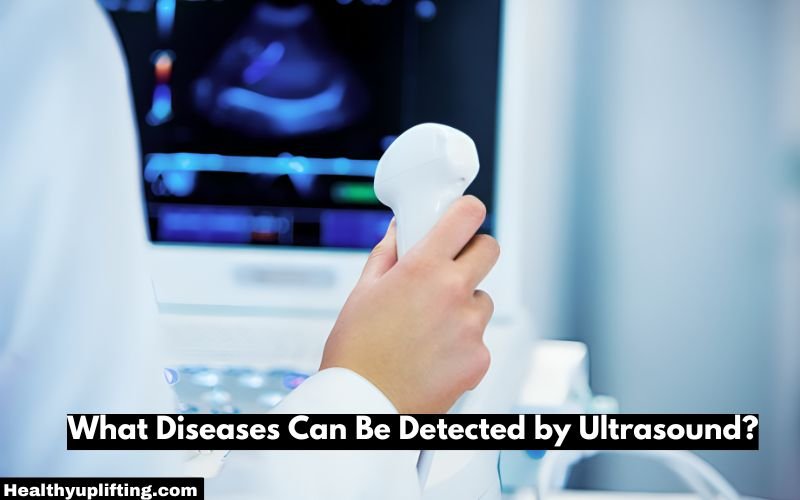Ultrasound, also known as sonography, is a diagnostic imaging technique that uses high-frequency sound waves to produce images of structures within the body. Unlike X-rays or CT scans, ultrasounds do not use ionizing radiation, making them a safer and non-invasive option for diagnostic imaging. While most people associate ultrasound with pregnancy, it plays a significant role in detecting various diseases and conditions in multiple areas of the body. This article delves into the wide array of diseases that can be detected by ultrasound.
How Ultrasound Works
Ultrasound devices emit high-frequency sound waves that penetrate tissues and bounce back when they encounter different structures in the body. The reflected sound waves, or echoes, are captured by the transducer and then processed by a computer to create real-time images of the organs, tissues, or vessels. The ability of ultrasound to capture detailed images of soft tissues makes it particularly valuable in detecting several diseases. Some ultrasounds also use Doppler technology to evaluate blood flow, which is essential for identifying circulatory disorders.
Categories of Diseases Detected by Ultrasound
Ultrasound can detect diseases across various categories of health conditions. These include but are not limited to:

- Cardiovascular Diseases
- Abdominal and Gastrointestinal Diseases
- Musculoskeletal Disorders
- Reproductive and Gynecological Diseases
- Urological Diseases
- Endocrine Disorders
- Oncological Diseases (Cancer)
- Pediatric Conditions
1. Cardiovascular Diseases
Cardiovascular diseases are one of the leading causes of mortality worldwide. Ultrasound, particularly echocardiography, plays an essential role in diagnosing various heart and vascular conditions. Some of these conditions include:
A. Heart Valve Diseases
Echocardiography is commonly used to assess heart valves and their function. Valvular diseases such as mitral valve prolapse, aortic stenosis, and regurgitation can be accurately detected through this imaging technique. The ultrasound assesses the movement of blood through the heart and the condition of the valves, helping cardiologists determine whether surgical intervention is needed.
B. Heart Failure
Ultrasound helps in the evaluation of heart failure by measuring the heart’s ability to pump blood. It can provide data on the ejection fraction, which indicates how well the heart is pumping with each beat. A reduced ejection fraction is a hallmark of heart failure, and ultrasound is essential in guiding treatment strategies.
C. Aneurysms
An abdominal ultrasound can detect aortic aneurysms, which are balloon-like bulges in the wall of a blood vessel. An aortic aneurysm can rupture and become life-threatening, making early detection crucial for surgical intervention.
D. Deep Vein Thrombosis (DVT)
Venous ultrasound is used to detect blood clots in veins, particularly in the legs, which may indicate deep vein thrombosis. If left untreated, DVT can lead to a pulmonary embolism, a condition where the clot breaks free and travels to the lungs. Consult experts like Rosen Vein Care to help with treatments.
2. Abdominal and Gastrointestinal Diseases
Ultrasound is also effective in diagnosing several abdominal and gastrointestinal conditions. This includes diseases affecting the liver, gallbladder, pancreas, kidneys, and intestines.
A. Liver Diseases
Liver ultrasound is commonly used to assess liver size, shape, and the presence of abnormalities such as:
- Fatty Liver Disease (Steatosis): Ultrasound is capable of detecting the accumulation of fat in liver cells, which may lead to non-alcoholic fatty liver disease (NAFLD). If left untreated, NAFLD can progress to more severe liver conditions like cirrhosis.
- Liver Cirrhosis: Cirrhosis involves scarring of the liver tissue, often caused by chronic liver diseases like hepatitis or long-term alcohol use. Ultrasound can detect irregularities in liver texture, blood flow, and enlargement of the spleen, which are indicative of cirrhosis.
- Liver Tumors: Ultrasound can identify both benign and malignant tumors in the liver, aiding in early detection of liver cancer or metastasis from cancers in other organs.
B. Gallbladder Diseases
Gallbladder ultrasound is primarily used to detect:
- Gallstones (Cholelithiasis): The formation of stones in the gallbladder can cause severe pain and infections. Ultrasound can visualize these stones and assess the need for surgical removal of the gallbladder.
- Cholecystitis: Inflammation of the gallbladder, often due to gallstones, can be detected with ultrasound. This condition typically requires immediate medical attention.
C. Pancreatic Diseases
Ultrasound is useful for identifying several pancreatic conditions, such as:
- Pancreatitis: Inflammation of the pancreas can cause severe abdominal pain and digestive issues. Ultrasound helps to identify inflammation and structural damage to the pancreas.
- Pancreatic Tumors: Though CT and MRI are more commonly used for detailed imaging of the pancreas, ultrasound can still help in the initial detection of tumors and guide further diagnostic procedures.
D. Kidney Diseases
Renal ultrasound provides vital information regarding the health of the kidneys. It is commonly used to detect:
- Kidney Stones: Ultrasound is a non-invasive way to detect kidney stones, which can block the urinary tract and cause significant pain.
- Polycystic Kidney Disease: This genetic disorder causes multiple cysts to form in the kidneys. Ultrasound can detect these cysts and monitor their growth over time.
- Hydronephrosis: This is the swelling of the kidneys due to urine buildup, often caused by blockages. Ultrasound is critical for diagnosing this condition and determining the extent of the blockage.
3. Musculoskeletal Disorders
Ultrasound is also effective for diagnosing musculoskeletal disorders. It is commonly used to assess soft tissue injuries and degenerative conditions in muscles, tendons, and joints.
A. Tendinitis
Ultrasound is commonly used to detect inflammation in tendons (tendinitis). For example, rotator cuff tendinitis in the shoulder or Achilles tendinitis in the heel can be effectively diagnosed using ultrasound.
B. Ligament Injuries
Ultrasound is an excellent tool for visualizing ligament tears, especially in the knee (anterior cruciate ligament) and ankle (lateral ligament). It can be used to evaluate soft tissue injuries in real-time, making it valuable for sports medicine.
C. Arthritis
Certain types of arthritis, including rheumatoid arthritis, can be detected by ultrasound. It helps identify joint inflammation, fluid accumulation, and the extent of cartilage damage, aiding in diagnosis and treatment planning.
4. Reproductive and Gynecological Diseases
In gynecology and obstetrics, ultrasound plays a crucial role in detecting diseases related to the reproductive system.
A. Ovarian Cysts and Tumors
Transvaginal ultrasound can detect ovarian cysts, tumors, and other abnormalities. Cysts are often benign, but some can lead to complications or indicate the presence of ovarian cancer.
B. Uterine Fibroids
Ultrasound is used to detect uterine fibroids, which are non-cancerous growths in the uterus. These fibroids can cause pain, heavy menstrual bleeding, and complications during pregnancy.
C. Endometriosis
Endometriosis occurs when tissue similar to the lining of the uterus grows outside of it. While ultrasound may not always detect small patches of endometriosis, it can identify larger lesions, ovarian cysts (endometriomas), and other abnormalities caused by the condition.
D. Pregnancy Complications
Beyond routine pregnancy checks, ultrasound is used to detect complications such as:
- Ectopic Pregnancy: Ultrasound is critical in detecting an ectopic pregnancy, where the embryo implants outside the uterus, often in the fallopian tubes. This condition requires immediate medical intervention.
- Placental Problems: Placenta previa (where the placenta covers the cervix) and placental abruption (where the placenta detaches from the uterine wall) are serious complications that can be detected with ultrasound.
5. Urological Diseases
Urological diseases affecting the bladder, prostate, and urinary system can be diagnosed using ultrasound.
A. Bladder Conditions
Ultrasound can be used to identify bladder stones, tumors, and signs of inflammation. It is also used to measure the amount of residual urine in the bladder after urination, which can indicate issues such as urinary retention.
B. Prostate Diseases
Prostate ultrasound, often performed with a transrectal probe, helps in diagnosing prostate enlargement (benign prostatic hyperplasia) and prostate cancer. It is also used to guide needle biopsies of the prostate.
6. Endocrine Disorders
The endocrine system, particularly the thyroid and parathyroid glands, can be effectively evaluated using ultrasound.
A. Thyroid Nodules
Ultrasound is the first-line imaging modality for evaluating thyroid nodules. It helps in assessing the size, location, and characteristics of the nodules and can guide fine-needle aspiration biopsies to check for cancer.
B. Parathyroid Diseases
Parathyroid ultrasound can detect abnormal enlargement of the parathyroid glands, often associated with hyperparathyroidism, a condition where excessive parathyroid hormone is produced, leading to elevated calcium levels in the blood.
7. Oncological Diseases (Cancer)
While other imaging techniques like CT scans or MRIs are typically used for detailed cancer diagnostics, ultrasound can be a valuable tool in detecting certain cancers.
A. Breast Cancer
Breast ultrasound is often used alongside mammography to detect breast cancer, particularly in women with dense breast tissue. It can help distinguish between fluid-filled cysts and solid tumors.
B. Liver and Pancreatic Cancers
As mentioned earlier, ultrasound can help detect tumors in the liver and pancreas, aiding in early diagnosis and treatment planning.
8. Pediatric Conditions
Ultrasound is especially valuable in pediatrics due to its non-invasive and radiation-free nature. Common pediatric conditions that can be detected by ultrasound include:
- Congenital Abnormalities: Ultrasound is used in newborns to detect congenital conditions such as hip dysplasia, where the hip joint is not properly formed.
- Hydrocephalus: In infants, cranial ultrasound can detect an abnormal buildup of fluid in the brain, known as hydrocephalus.
FAQs
What is ultrasound used for in medicine?
Ultrasound is used to create real-time images of internal organs, tissues, and blood flow, aiding in the diagnosis of a variety of medical conditions, including heart diseases, liver disorders, kidney problems, reproductive system abnormalities, and more.
How does ultrasound detect diseases?
Ultrasound uses high-frequency sound waves to produce images of internal structures. These sound waves bounce off tissues, and the reflected signals create detailed images of organs, blood vessels, and soft tissues, helping doctors identify abnormalities such as tumors, inflammation, or blockages.
What cardiovascular diseases can be detected by ultrasound?
Ultrasound can detect cardiovascular diseases such as heart valve disorders (e.g., mitral valve prolapse), heart failure, aortic aneurysms, and blood clots (deep vein thrombosis). Doppler ultrasound is often used to measure blood flow and assess the functioning of the heart and blood vessels.
Can ultrasound detect cancer?
Yes, ultrasound can help detect certain types of cancer, such as breast cancer, liver cancer, pancreatic cancer, and thyroid cancer. It is also commonly used to guide biopsies for diagnosing solid tumors. However, more detailed imaging techniques like CT or MRI may be used for cancer staging.
Can ultrasound detect gastrointestinal diseases?
Yes, ultrasound can detect various gastrointestinal diseases. It is particularly useful for diagnosing liver conditions (e.g., fatty liver, cirrhosis), gallbladder diseases (e.g., gallstones), pancreatic disorders (e.g., pancreatitis), and kidney diseases (e.g., kidney stones, hydronephrosis).
Conclusion
Ultrasound is a versatile diagnostic tool that can detect a wide range of diseases affecting different organ systems. From cardiovascular diseases to cancer, reproductive health, and musculoskeletal disorders, ultrasound’s non-invasive, radiation-free approach makes it an essential component of modern medical diagnostics. Its ability to provide real-time imaging ensures that conditions can be detected early, leading to more timely and effective treatments.
For More Information, Visit: HealthyUplfting.com

